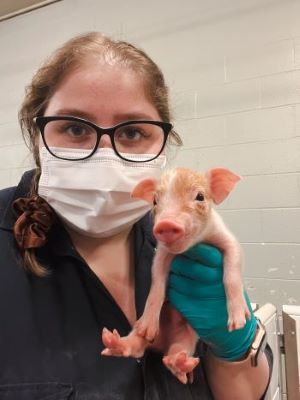Alive and well: Understanding risk factors for stillbirth and neonatal mortality in pigs

Growing up in Toronto, Sarah Hill didn’t have much exposure to agriculture, but she’s always been fascinated by farming, particularly pigs. Her early love of the industry might have been a sign that she’d find herself doing her PhD in swine research at the University of Guelph.
Hill is now completing her PhD in epidemiology with Dr. Bob Friendship, swine research co-ordinator in the Department of Population Medicine at the Ontario Veterinary College. She’s investigating how to reduce stillbirth and pre-weaning mortality in piglets.
“As litter size has increased over the past decade, we’ve also seen an increase in stillborn piglets and pre-weaning death,” says Hill. “We want to look at how to balance economics and welfare so that farmers can realize the economic benefit of larger litters but not at a cost to the piglet.”

Hoping to help sows deliver and nurse more piglets, she looked at risk factors for sows from late gestation through farrowing. Her project had two objectives: to examine a wide range of risk factors associated with stillbirths and farrowing (birthing) difficulties; and to learn whether pain medication (non-steroidal anti-inflammatory drugs or NSAIDs) administered at or around farrowing time would improve sow performance and reduce pre-weaning mortality.
Hill evaluated about 400 sows over a 14-month period at the Arkell Swine Research Facility, which is owned by Agricultural Research and Innovation Ontario (ARIO) and managed by the University of Guelph through the Ontario Agri-Food Innovation Alliance. “It’s great to have had a location like Arkell so we could study a large sample size over many months and evaluate the various risk factors of the sow,” she says.
Sows were assigned to one of three groups in a randomized control trial – treatment with one of two NSAIDS and a control group. Data collected included anemia, back fat, weight, litter size, piglet weight at birth and two weeks later, stillbirth and pre-wean mortality, as well as video footage of farrowing duration.
“I am still evaluating much of the data but can report that litter size averaged 14.5 piglets per litter with 13 born live and 1.5 stillborn,” says Hill. “And we did find that there was no association between sow anemia and the number of stillbirths.”
When it comes to the use of NSAIDs, Hill will be looking at the impact of an analgesic (pain-reducing) drug on farrowing duration. “We are hoping that if sows receive pain medication, especially those experiencing a difficult or lengthy farrow, they will be able to lie down more comfortably and nurse longer,” she says.
Farrowing duration is critical for the first 48 hours of a piglet’s life when they begin nursing and need to receive as much colostrum as possible to help with long-term health and viability. “We are interested in evaluating farrowing duration because a longer farrowing period may mean piglets born later don’t have access to as much quantity and quality of colostrum as those born earlier.”
Hill plans to complete data analysis and defend her PhD by the end of 2023. She hopes this research will impact and inform changes in the farrowing process that balance animal welfare and the bottom line.
As for the future, the barn doors are wide open for Hill. “I love research and thinking about innovative ways to make improvements in the swine industry, but I’m not sure what’s next.”
This research is funded by the Ontario Agri-Food Innovation Alliance, a collaboration between the Ontario Ministry of Agriculture, Food and Rural Affairs and the University of Guelph, and took place at the Arkell Swine Research Facility, which is owned by the ARIO.
In 2023, the Ontario government opened a new Ontario Swine Research Centre in Elora, Ont., that will continue to support the Ontario swine sector by facilitating future swine research and innovation.